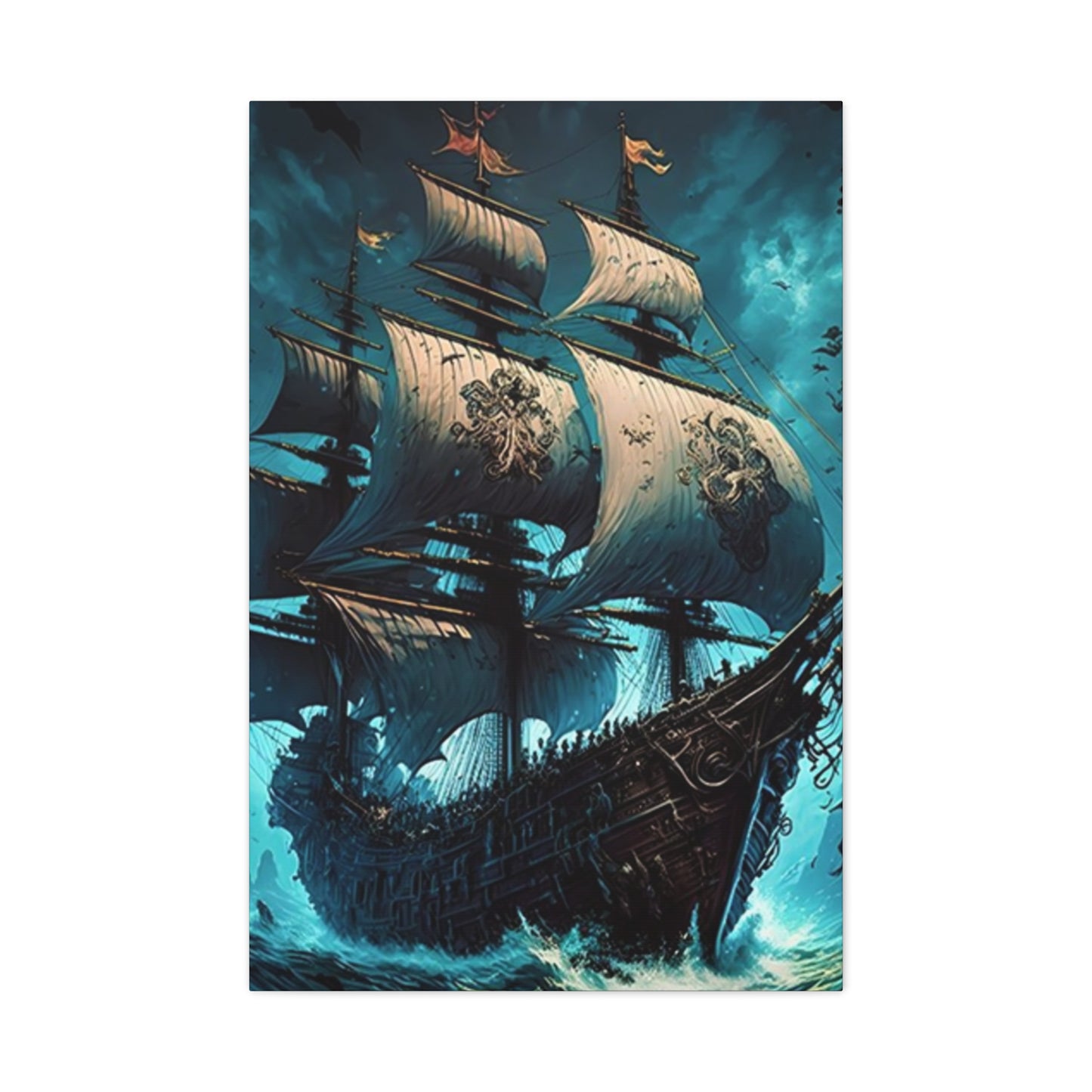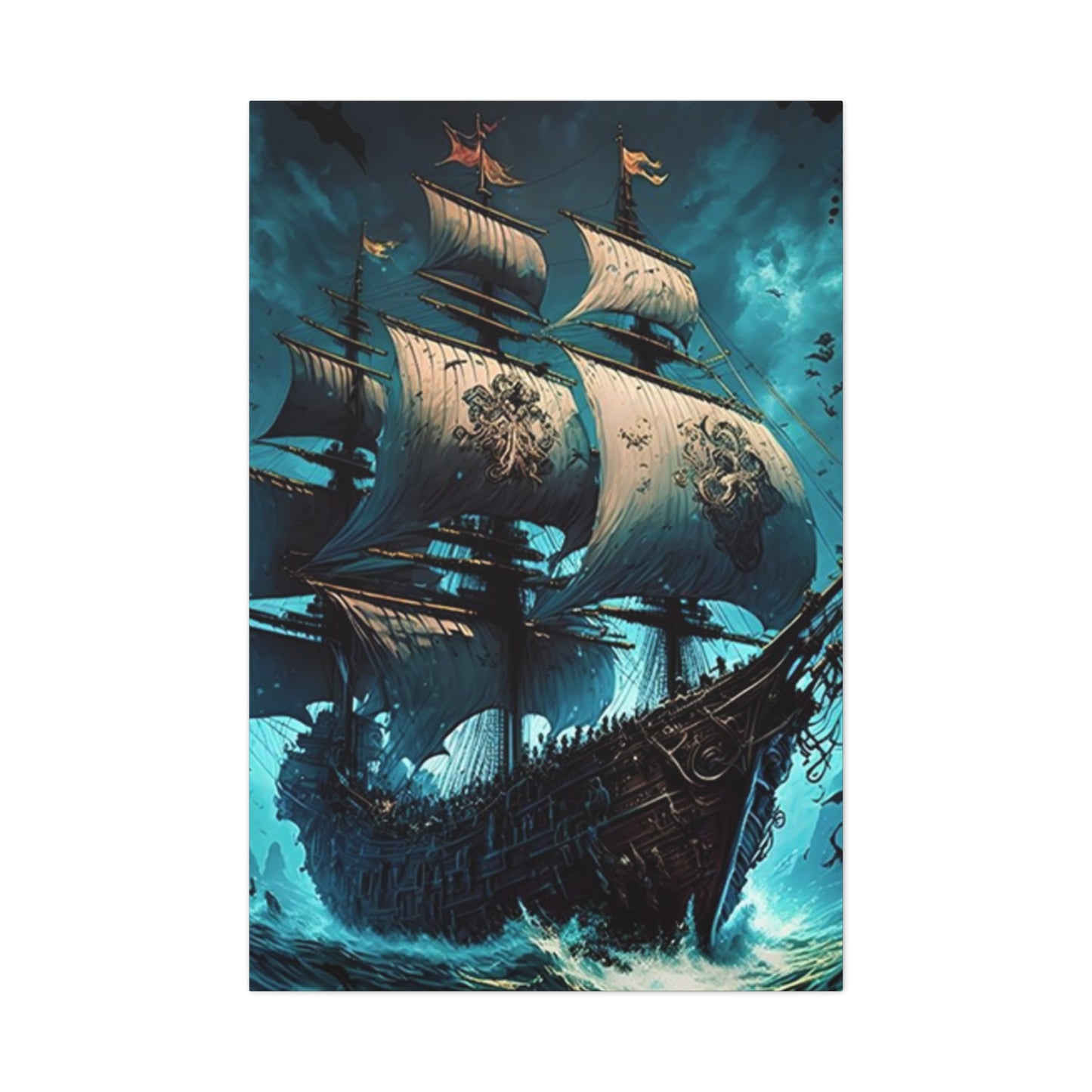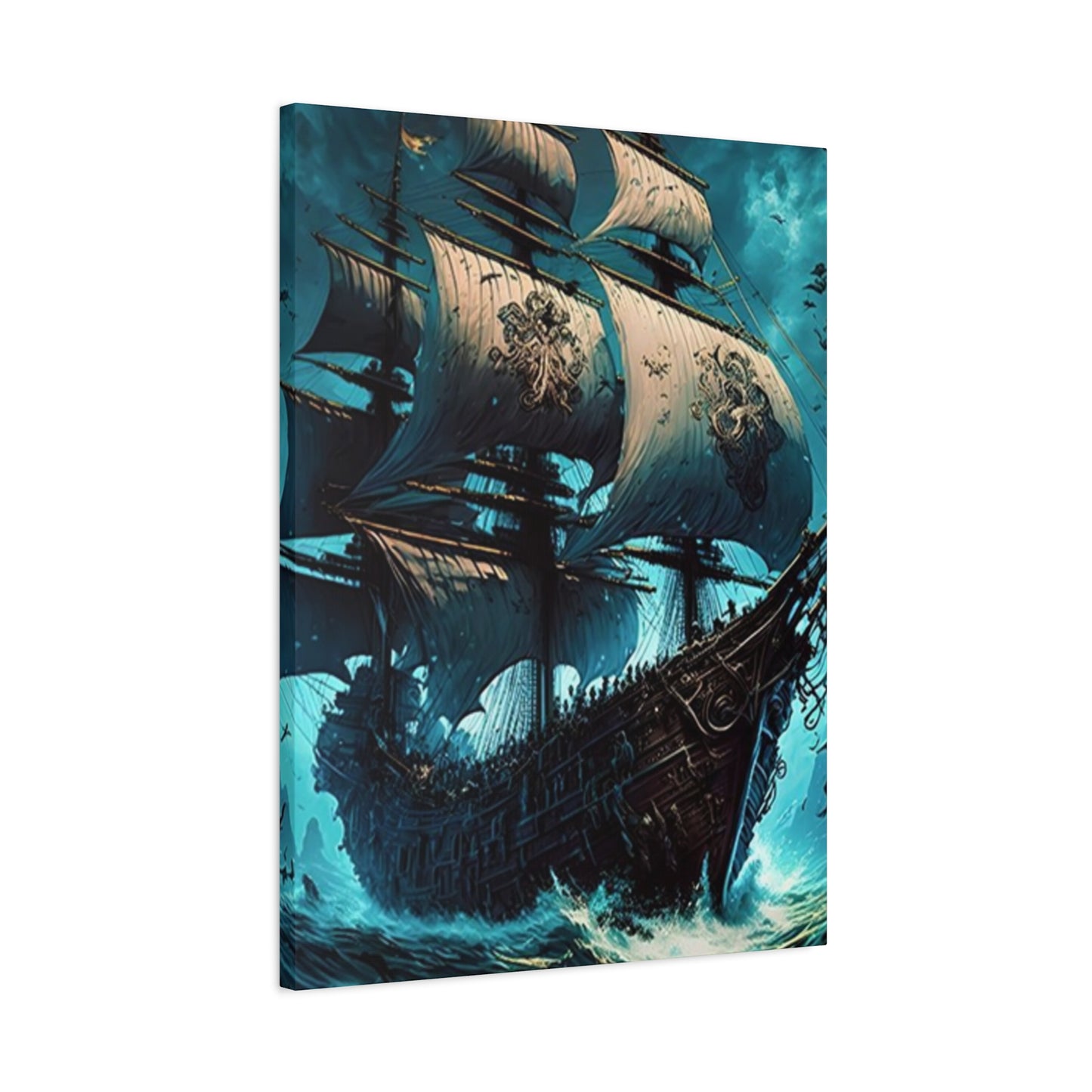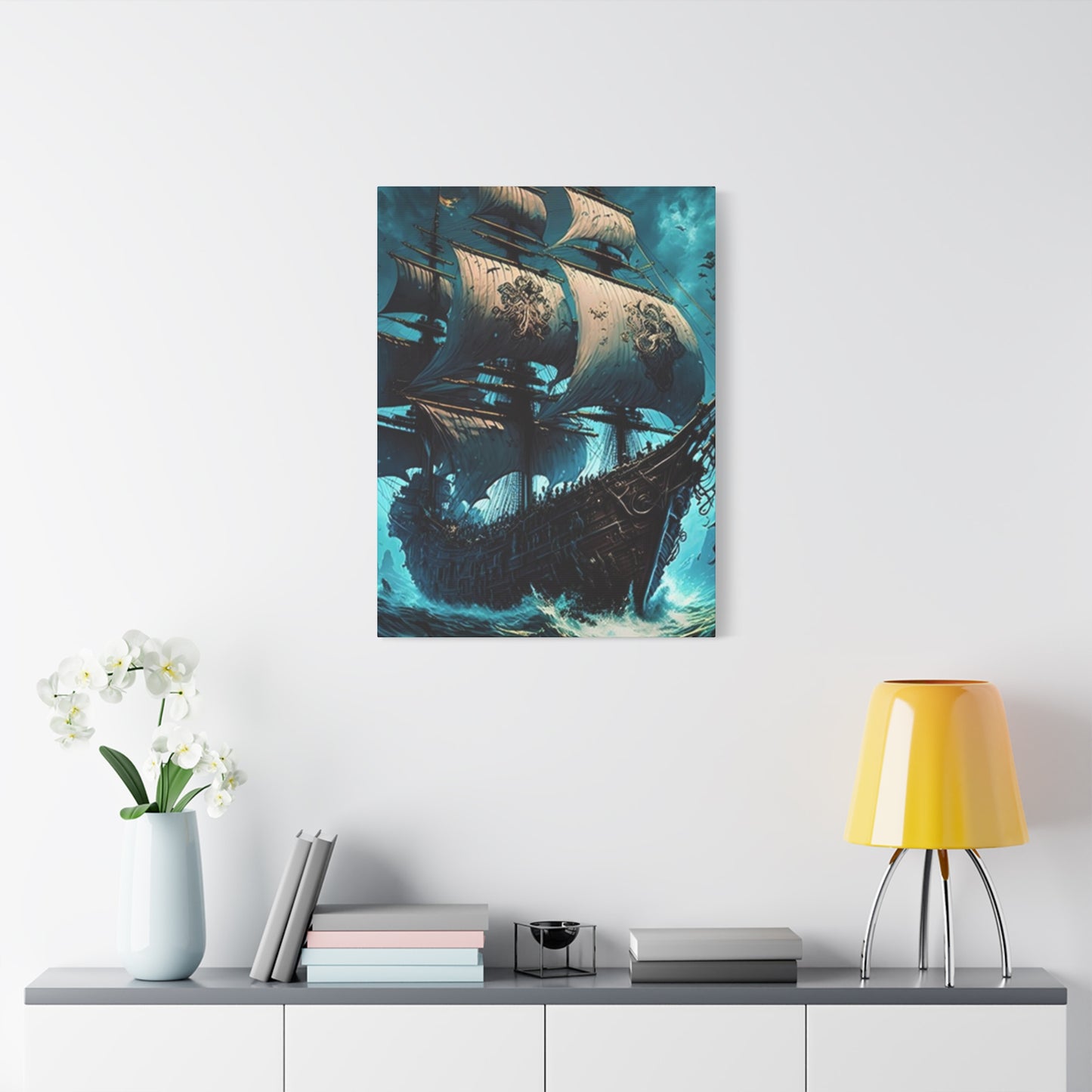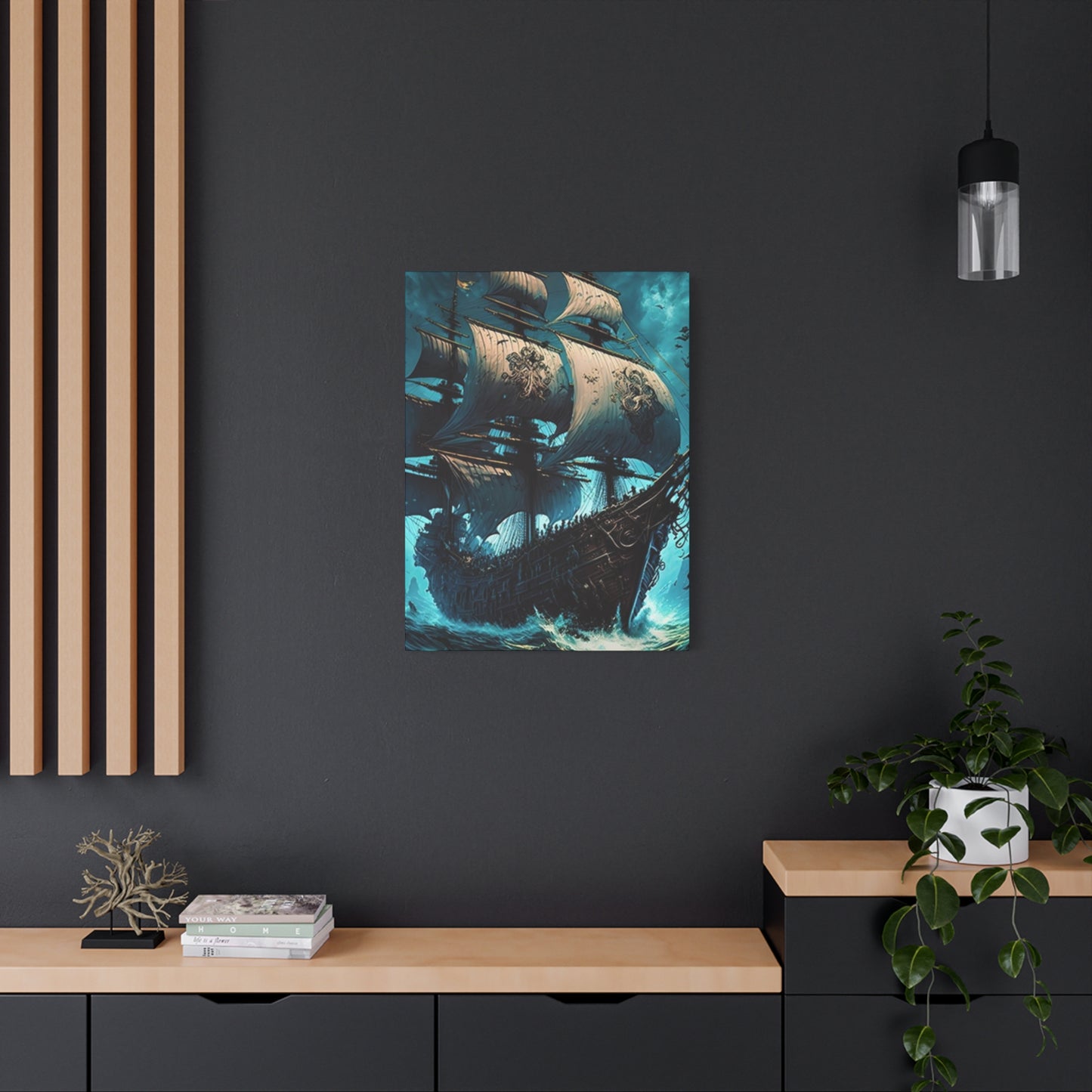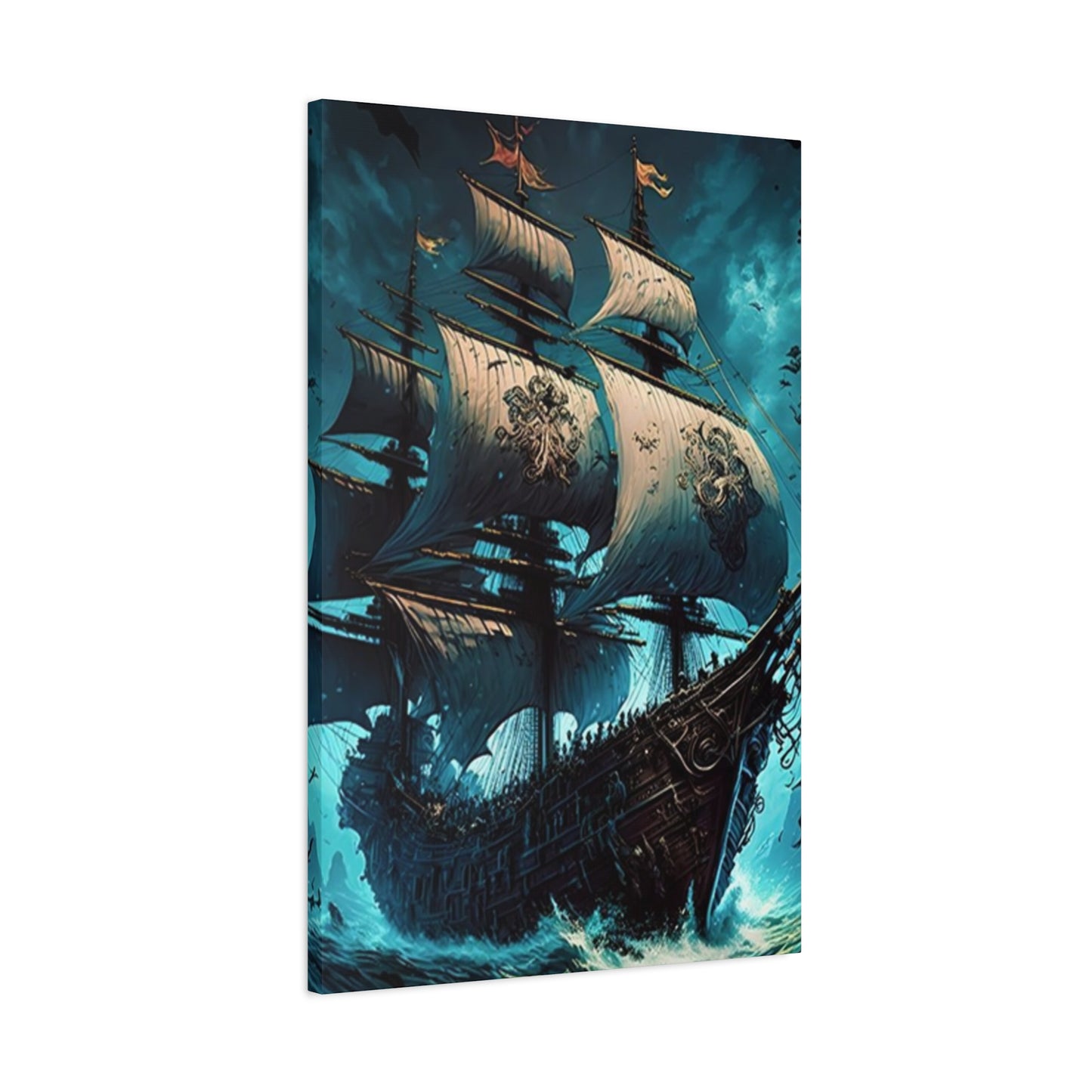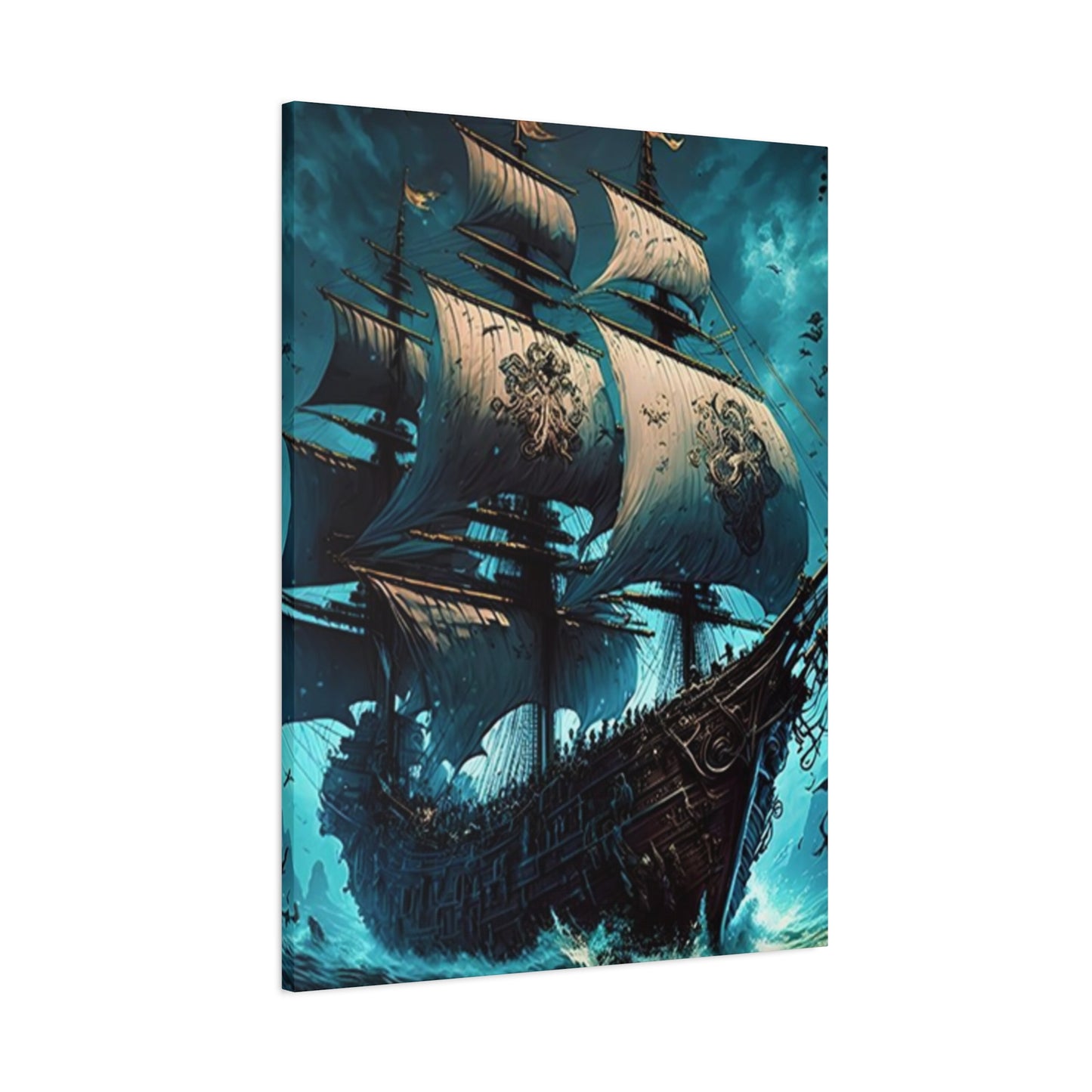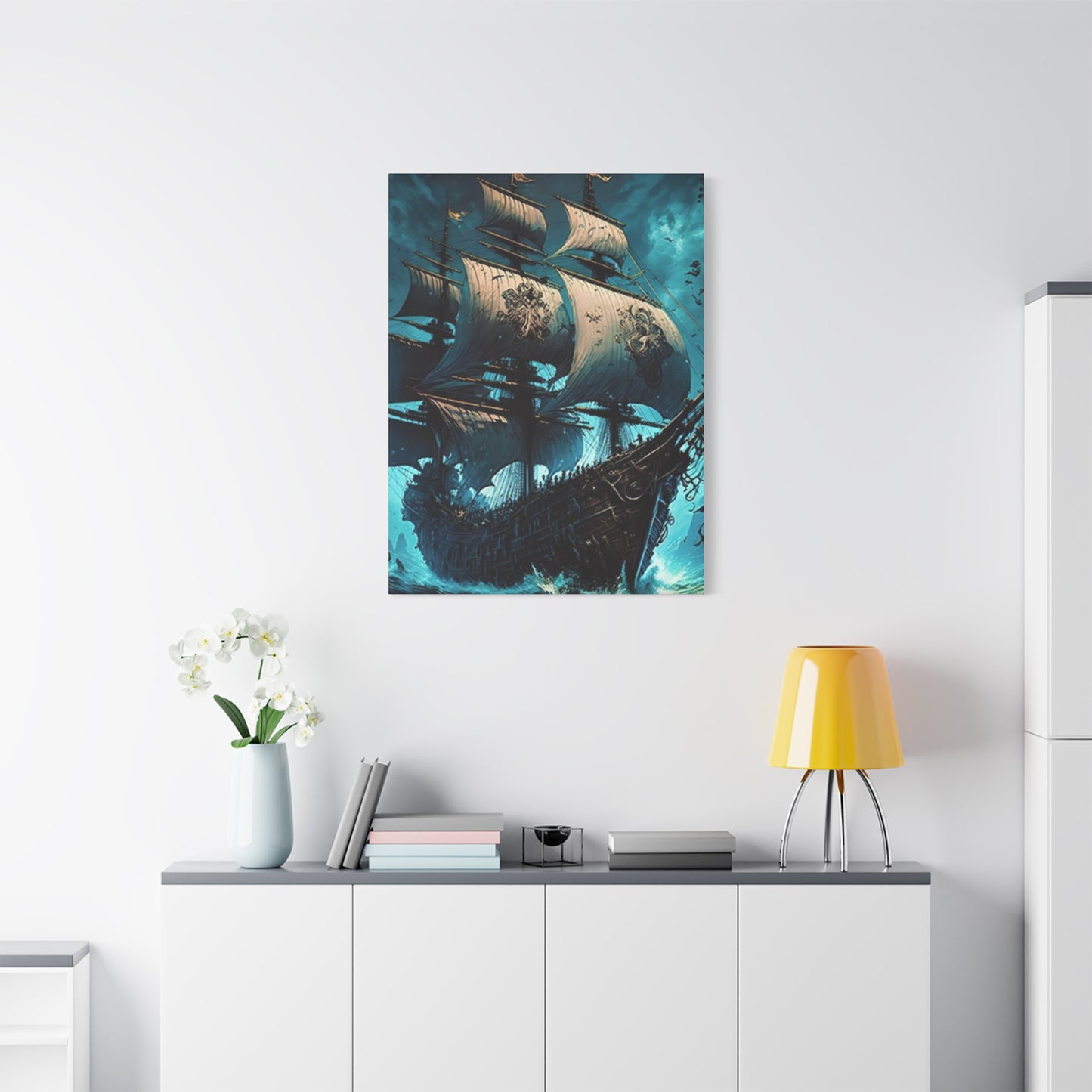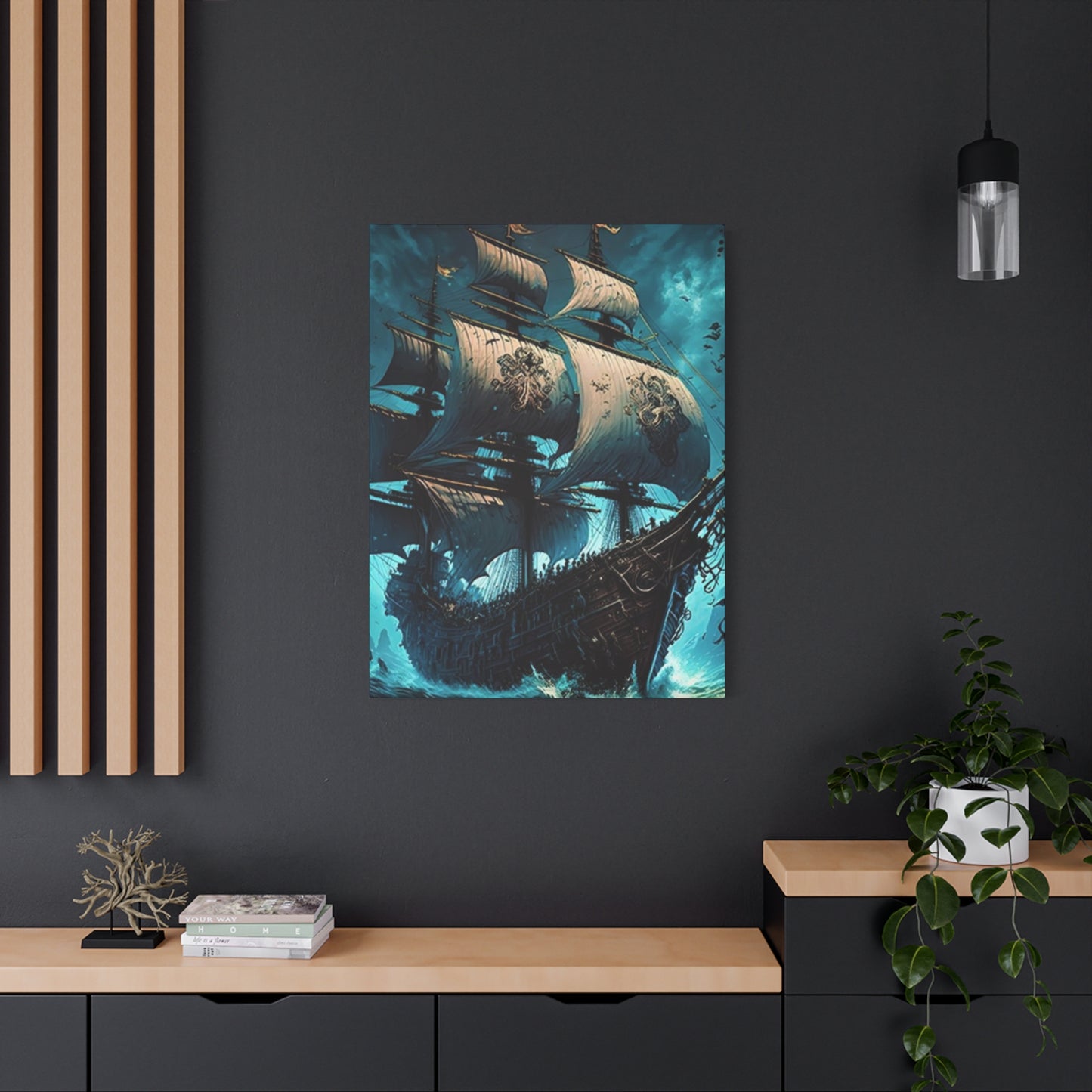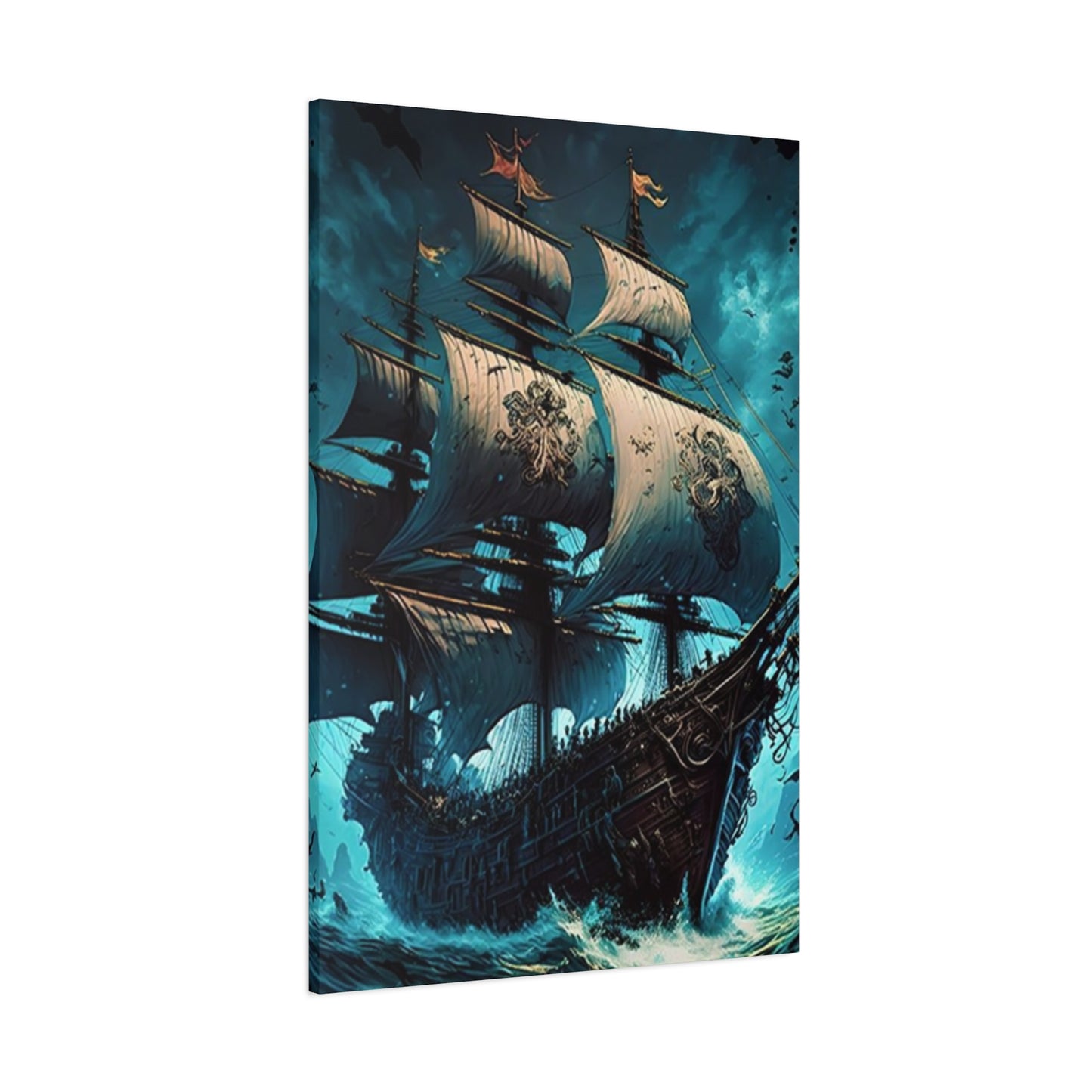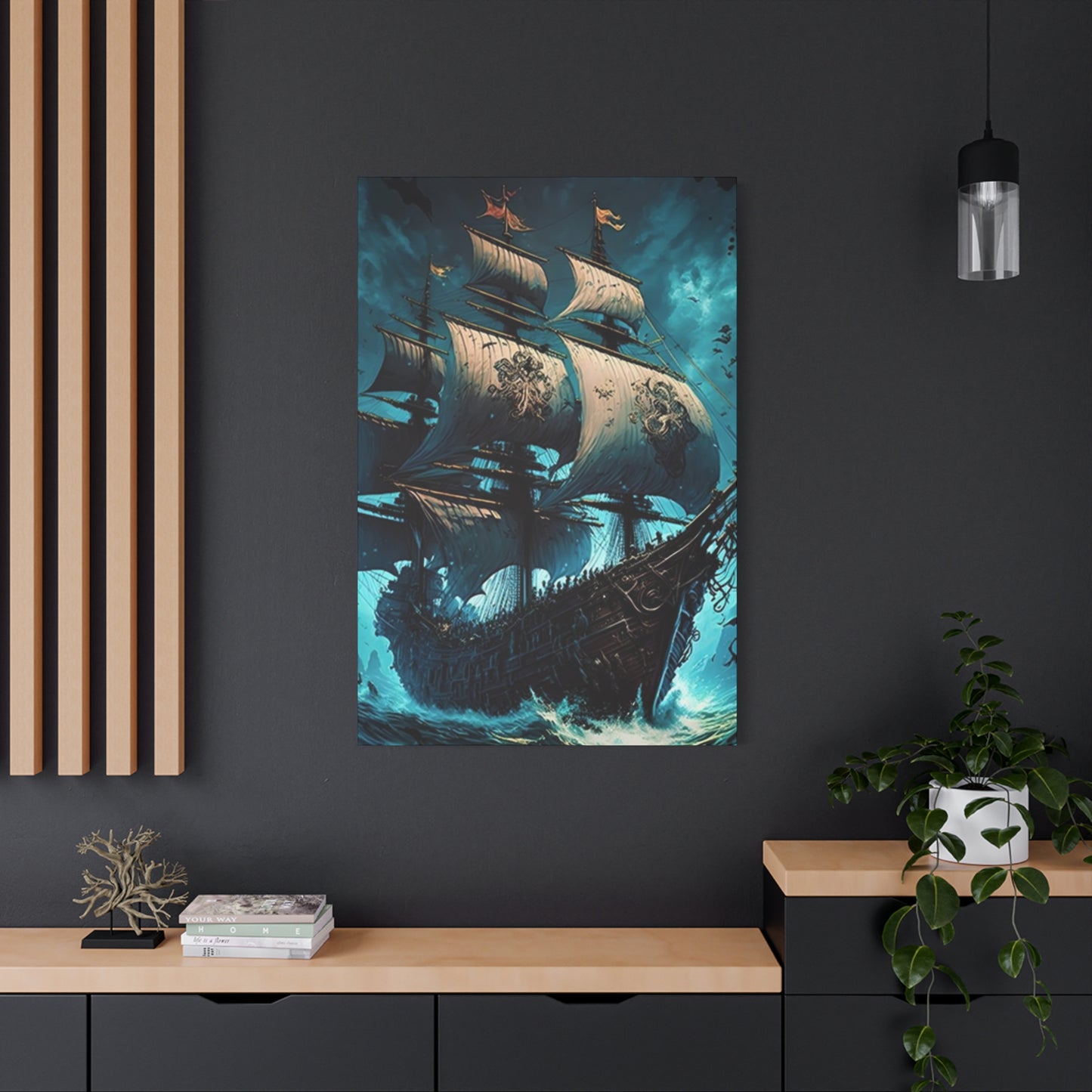The Ultimate Guide to Large Ship Sailing in Night Wall Art: Transform Your Space with Maritime Masterpieces
Maritime artwork featuring massive vessels navigating through dark waters has captivated art enthusiasts and interior designers for centuries. The combination of powerful ships cutting through moonlit waves creates a dramatic visual narrative that speaks to human adventure, exploration, and the mysteries of the ocean. These artistic representations showcase the contrast between human ingenuity and nature's raw power, making them perfect statement pieces for any living space.
The allure of such imagery stems from multiple psychological and aesthetic factors. When viewers gaze upon a grand vessel sailing beneath starlit skies, they experience a sense of wanderlust and contemplation. The darkness of night adds an element of mystery and drama that daytime scenes cannot capture. The interplay of shadows and highlights creates depth and dimension that draws the eye and encourages prolonged viewing. Whether displayed in a living room, office, or bedroom, these artworks serve as windows to distant horizons and untold adventures.
Furthermore, the symbolism embedded within these nautical scenes resonates deeply with many individuals. Ships have long represented journeys, both literal and metaphorical. They symbolize progress, determination, and the courage to venture into unknown territories. When depicted at night, this symbolism intensifies, suggesting navigation through life's darker moments with strength and purpose. The combination of these elements makes such artwork not merely decorative but meaningful and inspirational.
Defining the Dramatic Aesthetic of Large Ship Sailing in Night Wall Art
The dramatic aesthetic inherent in Large Ship Sailing in Night Wall Art is predicated on a careful balance of shadow form and minimal light achieving a unique visual impact that separates it from other genres of fine art. The core of this drama is the concept of chiaroscuro, the strong contrast between light and dark utilized to give the image a three-dimensional depth and striking intensity. In these artworks the ship itself is usually the brightest element often illuminated by its own lanterns, a distant moon or reflected water light. This illumination serves not only to highlight the vessel's structure, its masts rigging or hull but also to emphasize the vast enveloping darkness that surrounds it.
The night sea is rarely rendered as a flat black; instead it utilizes a complex layering of dark blues greens and purples creating texture and movement within the shadows suggesting the hidden power of the waves. The large ship element is crucial as a small boat would appear lost or insignificant. The size of the vessel provides a sense of monumental scale giving the artwork an architectural presence that demands respect. Furthermore the sailing component introduces movement and narrative implying a continuous journey rather than a static moment. The lines of the sails or the wake trailing behind the hull guide the viewer's eye across the expansive scene reinforcing the panoramic feel.
This aesthetic is not passive; it is active and evocative, turning the wall into a dynamic boundary between the viewer's safe interior and the wild unpredictable expanse of the night sea. To successfully integrate this art form one must acknowledge and support this inherent drama allowing the Large Ship Sailing in Night Wall Art to command its space becoming a deep moody and highly sophisticated focal point that defines the entire atmosphere of the room it inhabits. The composition often employs a low horizon line to maximize the dominance of the sea and the sky further emphasizing the isolation and the immense scale of the journey undertaken by the vessel depicted.
Navigating the Seas in Art from Canvas to Digital Print
The artistic depiction of the sea and the vessels upon it is one of the most enduring themes in human history dating back to ancient craftwork yet the specific focus on Large Ship Sailing in Night Wall Art has a rich dedicated lineage. The Dutch Golden Age saw the rise of maritime painting as a major genre celebrating naval power trade and exploration. While much of this early work focused on daytime battles or port scenes, later artists began to explore the moodier philosophical aspects of the night voyage. Romantic painters of the 19th century notably artists like J.M.W.
Turner used the tumultuous night sea to explore themes of the sublime where the terrifying power of nature was depicted with overwhelming beauty often featuring ships dwarfed by storms or illuminated by dramatic moonlight. These massive oil-on-canvas works established the precedent for large-scale maritime drama, a direct artistic ancestor to the modern panorama. The shift into the 20th and 21st centuries saw photography take over the role of documenting and interpreting the sea. The advent of high-resolution digital imaging and specialized long-exposure techniques allowed for the capture of night seascapes with a level of detail and color fidelity previously unattainable.
Modern printing technologies such as giclée printing on archival canvas or high-definition prints on metal and acrylic have made it possible to reproduce these dramatic digital captures in the monumental immersive scales required for contemporary Large Ship Sailing in Night Wall Art a necessity for truly conveying the ocean's vastness. Thus the current popularity of this wall art is the culmination of centuries of artistic effort moving from the careful brushwork of a master painter to the sophisticated algorithms of a modern printing press all united by the timeless appreciation for the majestic sight of a great ship navigating the solitude of the dark boundless sea. This historical continuity grants the contemporary piece an added layer of gravitas linking the modern home to the grand tradition of naval and artistic exploration.
Emotional Impact of Oceanic Solitude
The act of placing a piece of Large Ship Sailing in Night Wall Art in one's personal space is an invitation to engage with deep-seated human emotions particularly those related to solitude and the unknown. Psychologically the imagery taps into the archetypal journey of life where the ship represents the self or destiny moving through the unpredictable waters of existence. The night setting amplifies this feeling of personal quest providing a sense of quiet isolation that many find deeply meditative and comforting. In a world characterized by constant connectivity and stimulation the visual representation of oceanic solitude offers a mental escape, a moment of profound quiet reflection.
The absence of a clear horizon in the dark sea creates a visual ambiguity that engages the mind encouraging the viewer to project their own thoughts and interpretations onto the scene enhancing the art's personal resonance. Furthermore the ship as a symbol of human mastery and resilience provides a psychological anchor. Despite the overwhelming darkness the vessel is still moving forward its lights signaling perseverance and hope. This subtle messaging makes the art an excellent choice for office studies or any area where focus and mental strength are desired.
The inherent cooling palette of deep blues and blacks also contributes to a sense of calm and reduction of anxiety creating a sophisticated backdrop for unwinding. Unlike art that shouts with bright colors and busy forms the aesthetic of Large Ship Sailing in Night Wall Art whispers of powerful quiet journeys making it a therapeutic element that fosters introspection and provides a daily reminder of the capacity for human strength even when faced with the vastness of the unknown. The composition's focus on a single vessel reinforces the idea of individual purpose and determination, a powerful visual affirmation for the occupant of the space.
Selecting the Ideal Vessel: From Clippers to Modern Cruisers in Art
When choosing the perfect piece of Large Ship Sailing in Night Wall Art, the selection of the vessel itself is a critical factor that dictates the overall style and narrative of the room. The type of ship depicted carries its own historical weight and aesthetic characteristics which will profoundly influence the interpretation of the maritime scene. For a classic traditional or masculine study, the ideal choice is often a historical sailing vessel such as a square-rigged clipper ship or a grand frigate. These ships with their intricate rigging and towering masts symbolize the age of exploration and romantic adventure providing a narrative of historical grandeur and complex engineering against the simplicity of the night sky.
Their forms are inherently dramatic creating sharp elegant silhouettes against the dark water. Conversely for a more modern minimalist or architectural space a contemporary vessel might be more appropriate. This could include a large sleek container ship or a luxurious futuristic cruise liner depicted as a beacon of light cutting through the midnight ocean. These modern forms speak to current globalization and technology offering a clean geometric contrast to the organic shapes of the water and sky.
The choice between historical and modern is a decision about the room's thematic center whether it leans toward nostalgic romance or sleek contemporary power. Regardless of the era the ship must be large to fulfill the promise of the large ship sailing in night theme ensuring its scale dominates the composition and provides the necessary drama and monumental presence to truly master the interior aesthetic. The selection must ultimately align with the homeowner’s personal connection to the sea and the specific emotional or historical narrative they wish to anchor within their living space ensuring the chosen ship’s silhouette and lighting scheme harmonize with the intended interior mood.
The Mastery of Mood: Utilizing Dark Palettes and Contrasting Light
The successful integration of Large Ship Sailing in Night Wall Art relies heavily on understanding its dark palette and how to use contrasting light to maximize its dramatic mood. The artwork itself is predominantly characterized by deep hues—indigo midnight blues, carbon blacks and rich purples—which are generally considered challenging in interior design but are essential for conveying the vastness of the night ocean. To prevent the room from feeling oppressive or too dark these deep colors must be balanced with careful application of light both within the art and the surrounding decor. The ship's light itself, whether it is the warm glow of cabin windows or the sharp white of a navigational beacon, serves as the art's internal contrast, a crucial focal point that draws the eye and provides visual relief. In the room designers should utilize targeted accent lighting such as adjustable track lighting or picture lights positioned to graze the surface of the art.
This grazing effect enhances the texture of the medium and makes the internal light sources of the ship appear more intense allowing the dark background colors to recede and create a sense of three-dimensional depth. Furthermore the rest of the room's palette should be thoughtfully chosen. Light neutral colors—soft grays, pale creams or white walls—can provide a clean boundary that makes the dark art stand out dramatically while the use of reflective materials like glass metallic frames or polished wood helps bounce light around the room preventing a cave-like atmosphere. The mastery of mood in this context is about creating a deliberate, sophisticated tension: a cozy illuminated interior that frames the powerful, moody drama of the boundless dark ocean journey depicted in the Large Ship Sailing in Night Wall Art thereby establishing an atmosphere of contemplative elegance and power.
Defining Majesty of Large Ship Sailing in Night Wall Art
The integration of Large Ship Sailing in Night Wall Art into a contemporary or classic interior is not a fleeting trend but a sophisticated design choice that taps into enduring human fascination with the sea exploration and the quiet strength found in solitude. This art form, defined by its dramatic scale and the powerful contrast between a large ship and the enveloping night, serves as much more than a decorative element; it is an architectural and psychological focal point. Its aesthetic power lies in its deep, moody palette, utilizing the rich complexity of night colors—indigos, slate grays, and black—interrupted only by the focused, hopeful luminescence of the vessel itself.
This chiaroscuro effect transforms a flat wall into a dynamic, three-dimensional window onto the vast, unpredictable ocean, fostering an atmosphere of introspection, awe, and quiet determination. We have seen that this style of wall art carries the weight of history, drawing lineage from Romantic painters who sought to capture the sublime power of nature and updated by modern digital printing techniques that allow for breathtaking, immersive scale. Psychologically, the imagery of a ship on a vast, dark sea resonates deeply, providing a sense of meditative escape and a potent symbol of life’s journey, resilience, and the mastery of self amid uncertainty. The careful selection of the vessel, whether a majestic clipper ship or a modern, sleek cruiser, determines the room’s narrative, while the strategic use of accent lighting is crucial for transforming the art’s inherent darkness into a source of dramatic, sophisticated elegance.
Ultimately, choosing Large Ship Sailing in Night Wall Art is an act of infusing a home with meaning and majesty. It anchors the interior space with a profound visual narrative, offering a daily reminder of the world’s quiet grandeur and the enduring human spirit to navigate the unknown. It stands as a timeless and powerful expression of design, ensuring that the finished room is not merely decorated but is truly mastered by the presence of a maritime masterpiece, a voyage of light captured in time for perennial inspiration. This is the enduring legacy and defining majesty of this specific, powerful art genre in modern home design.
Lighting Techniques That Bring Nighttime Scenes to Life
Proper illumination transforms maritime artwork from static decoration into dynamic visual experience. Picture lights mounted directly above frames provide focused illumination that highlights details while creating dramatic shadows that enhance depth perception. LED strip lighting behind gallery-wrapped canvas creates halo effects that make artwork appear to float on walls while adding ambient lighting to rooms. These approaches draw attention to featured pieces while contributing to overall lighting schemes.
Adjustable track lighting offers flexibility for highlighting multiple artworks or repositioning as collections change. Directional heads allow precise beam control, preventing glare on reflective surfaces while ensuring even illumination across canvas surfaces. Dimmable options enable atmosphere adjustment, intensifying artwork presence during evening hours or softening during daytime when natural light predominates. Color temperature selection affects mood, with warmer tones enhancing traditional pieces and cooler lights complementing contemporary presentations.
Natural lighting requires careful consideration to prevent damage while utilizing its enhancing qualities. Direct sunlight causes fading and degradation, necessitating UV-protective glazing or strategic placement away from windows. Indirect natural light during daytime creates changing appearance as sun angles shift, adding temporal dimension to static imagery. Sheer curtains or blinds provide control over light intensity while maintaining connection to outdoor environment. The interplay between natural and artificial lighting creates dynamic viewing experiences throughout daily cycles.
Integrating Maritime Art with Various Interior Design Styles
Coastal and nautical design schemes naturally accommodate ship imagery, creating cohesive themes that extend from artwork to furnishings and accessories. Palette coordination using blues, whites, and natural wood tones reinforces maritime connections while maintaining sophisticated rather than themed appearance. Rope accents, weathered textures, and marine-inspired decor complement rather than compete with featured artwork, creating unified aesthetic narratives.
Contemporary and modern interiors benefit from maritime artwork's bold visual impact and inherent geometric qualities. Ships' angular structures and rigging lines provide visual interest that enhances minimalist spaces without cluttering. Monochromatic or limited-palette pieces maintain contemporary sensibilities while introducing organic ocean elements that soften hard-edged modern design. The contrast between sleek furnishings and traditional nautical subject matter creates engaging visual tension that defines eclectic contemporary style.
Traditional and classic interiors embrace maritime artwork's historical associations and timeless appeal. Ornately framed pieces coordinate with formal furnishings, oriental rugs, and architectural details like crown molding and wainscoting. The artwork's classical subject matter reinforces traditional values of craftsmanship, exploration, and maritime heritage. Positioning within symmetrical arrangements and formal room layouts emphasizes order and tradition, creating refined environments that honor artistic and cultural legacies.
Industrial settings gain unexpected sophistication from maritime artwork that bridges rugged aesthetics with artistic refinement. Exposed brick, concrete, and metal elements provide neutral backgrounds that emphasize artwork without competing for attention. The combination of maritime history with industrial materials creates narrative connections to shipping ports, dockyards, and maritime commerce. Metal prints on aluminum particularly suit these environments, their contemporary production methods aligning with industrial design philosophy while nautical content adds human warmth.
The Symbolism Behind Ships Navigating Through Darkness
Maritime vessels journeying through nocturnal waters carry profound symbolic significance that resonates across cultures and personal experiences. Ships represent individuals or communities navigating life's challenges, with darkness symbolizing uncertainty, hardship, or unknown futures. The vessel's steady progress despite obscured surroundings suggests resilience, faith, and determination to continue forward even when destinations remain unseen. This metaphor provides inspiration during difficult periods, reminding viewers of human capacity to persevere.
The night setting amplifies emotional dimensions absent in daytime maritime scenes. Darkness evokes mystery and the subconscious mind, suggesting deeper exploration of internal landscapes alongside external journeys. Stars and moon provide guidance analogous to inner wisdom and external support systems that help navigate challenging times. The solitude of a ship at night reflects individual experience and self-reliance, while suggesting the universal nature of personal struggles and triumphs.
Different ship types carry additional symbolic layers. Historic sailing vessels suggest connection to tradition, heritage, and time-tested methods of progress. Their reliance on natural wind power represents working with rather than against natural forces, finding ways to harness challenges as propulsion. Modern ships might symbolize technological advancement and human innovation, progress achieved through ingenuity and adaptation. Luxury liners evoke leisure, exploration for pleasure rather than necessity, and the romantic aspects of travel and adventure.
Creating Gallery Walls with Multiple Maritime Pieces
Curating multiple nautical artworks into cohesive gallery arrangements allows sophisticated storytelling and visual complexity beyond single pieces. Thematic consistency through shared color palettes, time periods, or subject matter creates unity while varied sizes and orientations maintain interest. Beginning with the largest or most significant piece as an anchor, surrounding elements build outward following balanced composition principles that distribute visual weight evenly.
Grid arrangements deliver orderly, contemporary aesthetics suitable for modern interiors. Uniform spacing and aligned edges create clean geometric patterns that complement minimalist design philosophies. This approach works well with similarly sized pieces or multiples from the same series, maintaining coherence through repetition and structure. Salon-style arrangements embrace organic clustering with varied sizes, frames, and spacing that suggest collected-over-time authenticity. This approach suits eclectic and traditional interiors where personality and history layer to create character.
Planning gallery walls requires careful measurement and layout testing before installation. Paper templates matching artwork dimensions allow experimental arrangements on floors or temporary wall positioning with removable tape. This process prevents unnecessary holes while enabling configuration refinement. Maintaining consistent spacing between pieces, typically two to three inches, creates relationship without crowding. Ensuring the overall arrangement's outer edges form deliberate shapes like rectangles or gentle curves rather than random patterns produces polished results.
Seasonal and Temporal Considerations for Maritime Displays
While nautical artwork provides year-round appeal, strategic seasonal refreshing maintains visual interest and responds to changing light conditions and moods. Summer months invite lighter, brighter maritime scenes that celebrate ocean accessibility and vacation associations. Artwork emphasizing moonlit waters, clear starry skies, and calm seas enhances warm-weather aesthetics and indoor-outdoor living philosophies. Lighter frames and minimal presentation suit seasonal casualness.
Autumn and winter naturally align with dramatic nighttime maritime scenes featuring stormy seas and ships battling elements. Darker palettes complement seasonal light reduction and cozy interior emphasis. Artwork suggesting strength against adversity resonates with winter's challenges, providing visual warmth through rich colors and dynamic compositions. Traditional framing and layered presentation suit cooler months' inclination toward nesting and interior focus.
Holiday seasons offer opportunities for temporary maritime displays that celebrate specific occasions. Nautical artwork fits naturally into nautical-themed celebrations, seaside holiday homes, or rooms decorated in complementary coastal schemes. Temporary repositioning or rotating collections keeps familiar spaces feeling fresh without requiring new purchases. Seasonal artwork rotation also allows collectors to build larger portfolios than wall space would otherwise permit, varying displays throughout the year.
Caring for and Maintaining Maritime Wall Decorations
Proper maintenance preserves artwork quality and appearance across years or decades. Regular dusting using soft, dry microfiber cloths prevents accumulation that dulls surfaces and infiltrates canvas textures. Avoiding cleaning products unless specifically formulated for artwork prevents damage to protective coatings and pigments. For glass or acrylic surfaces, specialized cleaners designed for those materials ensure streak-free clarity without scratching or residue.
Environmental control significantly affects artwork longevity. Maintaining moderate humidity levels between 40 and 60 percent prevents canvas warping, mold growth, or moisture damage to frames and substrates. Temperature stability avoids expansion and contraction that stresses materials and mounting systems. Positioning artwork away from heating vents, radiators, and air conditioning ducts protects against temperature fluctuations and air currents carrying dust and contaminants.
UV protection prevents fading and degradation particularly crucial for paper-based prints and some canvas types. UV-filtering glass or acrylic in framed pieces blocks harmful wavelengths while maintaining visual clarity. Window treatments controlling direct sunlight exposure complement protective glazing. For unframed or glass-free pieces, UV-protective sprays provide invisible barriers, though professional application ensures even coverage without texture alteration. Regular inspection catches developing issues like frame loosening, mounting system wear, or early damage signs enabling timely intervention.
Investment Value and Collectibility of Maritime Artwork
Maritime art encompasses pieces ranging from affordable reproductions to valuable originals commanding substantial prices. Limited edition prints from recognized artists offer collectibility and appreciation potential at accessible entry points. Edition numbers indicating total print runs determine scarcity, with lower numbers and artist proofs commanding premiums. Certificates of authenticity documenting edition numbers, artist signatures, and provenance establish legitimacy and support future valuations.
Original paintings represent premium investments with unique status and maximum appreciation potential. Provenance documentation tracing ownership history and exhibition records enhances value and authenticity verification. Condition assessments from qualified appraisers establish current states and restoration needs affecting valuations. Maritime specialists bring focused expertise to nautical artwork evaluation, understanding historical context, artist significance, and market trends specific to this genre.
Building maritime art collections requires strategic approaches balancing aesthetic preferences with investment considerations. Focusing on specific periods, artists, or ship types creates coherent collections with enhanced significance and potential value. Emerging artists offer acquisition opportunities before wider recognition increases prices, though established artists provide stability and recognized value. Documentation maintenance including purchase receipts, certificates, appraisals, and condition reports supports insurance coverage and future sales while tracking collection evolution.
Customization Options for Personalized Maritime Displays
Commissioned artwork allows complete personalization reflecting specific preferences, memories, or meaningful locations. Working directly with artists to specify ship types, time settings, weather conditions, and compositional elements creates unique pieces unavailable through standard offerings. Incorporating specific vessels with personal significance like cruise ships from memorable vacations or historic ships reflecting heritage connections adds emotional resonance beyond generic maritime imagery.
Digital printing technology enables personalization of existing artwork or photography. Personal photographs of maritime experiences can be professionally enlarged and printed on canvas, metal, or acrylic for museum-quality presentation. Image enhancement adjusts lighting, color saturation, and composition for optimal wall display. Text additions incorporating meaningful quotes, dates, or locations transform artwork into commemorative pieces celebrating specific experiences or honoring maritime traditions.
Size customization adapts artwork precisely to available spaces without compromising composition integrity. Professional printing services resize images maintaining aspect ratios and detail clarity across various dimensions. Color adjustments coordinate palettes with existing decor schemes while preserving artistic intent. Material selection tailored to room functions and aesthetic preferences ensures practical suitability alongside visual appeal. These customization options transform commercial artwork into personal statements reflecting individual tastes and stories.
Digital vs. Traditional Art Representations
Traditional painted maritime artwork offers textural richness and handcrafted authenticity that digital reproductions cannot fully replicate. Visible brushstrokes, paint layering, and surface variations create dimensional quality and artistic presence particularly valued by collectors and purists. Original paintings represent singular creations with inherent uniqueness and direct artist connection. Traditional techniques using oil, acrylic, or watercolor on canvas or paper continue centuries-old artistic practices, maintaining cultural and technical heritage.
Digital maritime art embraces contemporary technology enabling effects and precision impossible through traditional methods. Digital painting software allows infinite color palettes, perfect symmetry when desired, and easy compositional experimentation. Photographic elements can be seamlessly integrated with painted elements, creating hybrid works combining realism and artistic interpretation. Digital files enable reproduction at various sizes without quality loss, democratizing art access through affordable prints while maintaining image integrity.
Hybrid approaches combine traditional and digital techniques, leveraging strengths of both. Artists might create initial paintings traditionally, then digitally enhance, adjust colors, or add elements impossible with physical media. Alternatively, digital sketches can guide traditional painting, with final works digitized for print reproduction. These blended methods reflect contemporary artistic practices where medium boundaries blur, focusing on creative vision rather than technical purism. Understanding these distinctions helps buyers appreciate artistic processes and make informed selections.
Maritime Artwork as Conversation Starters and Story Catalysts
Distinctive artwork naturally generates conversation, with maritime scenes particularly effective at prompting stories, memories, and discussions. Visitors drawn to dramatic nocturnal ship imagery often share personal ocean experiences, sailing adventures, or family maritime connections. These exchanges transform artwork from passive decoration into social catalysts fostering meaningful interactions. Hosting capabilities enhance when homes contain interesting visual elements that provide conversation foundations beyond small talk.
The universal appeal of ocean and travel themes creates accessible entry points for diverse audiences. Maritime imagery transcends cultural boundaries, as seafaring heritage exists across global civilizations. Even landlocked individuals recognize ships' symbolic significance and respond to artistic representations. This broad accessibility makes nautical artwork particularly suitable for spaces hosting varied guests or professional environments where inclusive conversation topics benefit relationships and networking.
Personal narratives embedded in artwork selections add depth to conversations. Explaining why specific pieces were chosen, whether commemorating travel experiences, honoring heritage, or simply aesthetic attraction, reveals personality and values. Discussing artist background, historical context of depicted vessels, or symbolic interpretations demonstrates cultural engagement and intellectual curiosity. These layers transform casual artwork appreciation into substantial exchanges building connections between individuals.
Pairing Maritime Art with Complementary Decor Elements
Creating cohesive interior aesthetics requires coordinating artwork with surrounding decorative elements, furniture, and architectural features. Nautical artwork naturally pairs with maritime accessories including decorative ship wheels, vintage compasses, rope-wrapped accents, and weathered wood furnishings. These elements reinforce thematic consistency while avoiding heavy-handed matching that appears contrived. Selective rather than comprehensive theming maintains sophistication and adult sensibility.
Color coordination extends maritime palettes throughout spaces without literal repetition. Navy or midnight blue from nighttime ocean artwork can appear in throw pillows, area rugs, or upholstery fabrics, creating visual connections without matching exactly. Metallic accents from moon and starlight reflections might inform hardware finishes, light fixtures, or decorative objects. These subtle relationships build cohesive environments where elements complement rather than compete.
Contrasting approaches can prove equally effective, particularly in contemporary or eclectic interiors. Positioning maritime artwork against unexpected color backgrounds like coral, emerald, or even black walls creates dramatic tension that highlights both elements. Pairing traditional nautical subject matter with modern furniture styles juxtaposes old and new, creating dynamic spaces reflecting layered interests. These contrasts require careful balance but deliver striking results when successfully executed.
Exploring Different Artistic Styles in Maritime Representation
Realistic maritime artwork emphasizes accurate ship details, precise wave mechanics, and faithful light rendering. These pieces appeal to nautical enthusiasts valuing historical accuracy and technical skill demonstration. Photorealistic paintings or high-resolution photography captures maritime subjects with documentary precision, serving educational purposes alongside aesthetic functions. This approach suits traditional interiors and viewers appreciating craftsmanship and dedication to authentic representation.
Impressionistic interpretations capture maritime essence through color, light, and movement suggestions rather than precise details. Loose brushwork and visible paint application create atmospheric qualities emphasizing emotional response over literal accuracy. These pieces work beautifully in spaces valuing artistic expression and romantic sensibilities. The softer focus and expressive techniques create dreamlike qualities particularly effective for relaxation spaces like bedrooms and meditation areas.
Abstract maritime artwork distills nautical elements to essential forms, colors, and compositions. Ships might appear as simplified silhouettes or geometric shapes, with water represented through color blocks and gestural marks rather than realistic waves. These pieces suit contemporary and modern interiors where artistic innovation and personal interpretation are valued. Abstract approaches allow viewers to project their own meanings and associations, creating interactive viewing experiences that evolve with repeated observation.
The Role of Technology in Modern Maritime Art Creation
Digital tools revolutionize maritime art creation, offering capabilities extending beyond traditional methods. 3D modeling software enables artists to construct detailed ship representations from any angle, ensuring structural accuracy while maintaining creative freedom. Digital painting programs provide infinite color mixing, instant corrections, and layer-based editing allowing complex compositions built incrementally. These technologies accelerate production while expanding creative possibilities.
Photography serves as foundation for contemporary maritime artwork through digital manipulation and enhancement. Sunset and nighttime ocean photographs provide realistic bases that artists transform through color grading, composition cropping, and element addition or removal. Multiple exposures can be blended creating impossible lighting scenarios or combining elements from different times and locations. These hybrid approaches deliver striking imagery combining photographic realism with artistic vision.
Artificial intelligence and machine learning introduce emerging possibilities in maritime art creation. Style transfer algorithms can apply famous artists' techniques to new maritime subjects, creating works emulating masters' aesthetics. Generative systems trained on maritime imagery can produce original compositions following specified parameters. While controversial regarding artistic authenticity, these technologies demonstrate evolving relationships between human creativity and computational capability, expanding definitions of artistic creation and authorship.
Maritime Artwork in Commercial and Professional Spaces
Corporate environments benefit from maritime artwork's sophisticated aesthetics and positive symbolic associations. Ships navigating darkness suggest organizational resilience, strategic thinking, and successful navigation of business challenges. Reception areas featuring impressive nautical pieces establish professional yet welcoming atmospheres, making strong first impressions on clients and visitors. Conference rooms gain inspirational elements encouraging creative thinking and bold decision-making through visual metaphors of exploration and discovery.
Hospitality venues naturally embrace maritime themes connecting to travel, relaxation, and exploration. Hotels, particularly those in coastal locations, use nautical artwork reinforcing sense of place and creating memorable guest experiences. Restaurants and bars gain atmosphere and personality through carefully selected maritime pieces coordinating with their overall design concepts. These commercial applications require larger, more durable pieces capable of withstanding public space demands while maintaining visual impact across years of display.
Medical facilities and healthcare environments leverage maritime artwork's calming properties supporting patient wellbeing and stress reduction. Ocean scenes in waiting areas provide visual distraction from anxiety, while the presence of ships suggests movement, progress, and positive outcomes. Therapeutic settings use maritime imagery in counseling offices and treatment rooms where creating peaceful, contemplative atmospheres supports healing processes. Research supports visual art's role in healthcare settings, with nature scenes including oceans demonstrating measurable benefits for patient outcomes and satisfaction.
Building Maritime Art Collections Across Time
Developing artwork collections represents ongoing journeys reflecting evolving tastes, expanding knowledge, and changing life circumstances. Beginning collectors benefit from focused approaches, perhaps concentrating on specific periods like golden age sailing or particular artists whose work consistently resonates. Building expertise gradually through research, gallery visits, and consultation with specialists develops confidence and refined aesthetic sensibilities. Early acquisitions need not be perfect or permanent, as collections naturally evolve through additions and occasional removals.
Documenting collections serves practical and sentimental purposes. Maintaining inventories with purchase information, artist details, and artwork specifications supports insurance coverage and estate planning. Photographing pieces creates visual records useful for identifying loss or damage while providing memories of collection evolution over time. Personal notes recording why pieces were acquired, their significance, and stories surrounding purchases add narrative dimensions transforming collections into autobiographies told through artistic selections.
Displaying entire collections simultaneously is often impossible given space limitations, leading to rotation strategies keeping visible artwork fresh and maintaining interest. Seasonal rotations, mood-based selections, or simple desire for change motivate periodic rehangings. Storing non-displayed pieces properly in climate-controlled conditions with protective wrapping preserves investment value. Some collectors designate specific rooms as galleries housing multiple pieces, creating immersive environments celebrating maritime art's diversity and their own collecting journeys.
Conclusion:
The enduring fascination with maritime vessels navigating through nocturnal waters reflects fundamental human experiences and aspirations that transcend time and culture. These powerful artistic representations combine aesthetic beauty with symbolic depth, offering viewers far more than simple wall decoration. They serve as windows into adventure, metaphors for life's journeys, and reminders of human resilience and ingenuity when facing nature's vastness and power.
Selecting and displaying such artwork involves numerous considerations spanning practical elements like sizing, placement, and material choices, alongside aesthetic decisions regarding style, color, and framing. Understanding these factors empowers individuals to make informed selections that enhance their living spaces while reflecting personal tastes and values. Whether embracing traditional approaches with ornately framed original paintings or choosing contemporary metal prints with minimalist presentation, countless options exist for incorporating maritime nocturnal scenes into residential and commercial environments.
The psychological benefits of maritime artwork extend beyond visual pleasure, contributing to stress reduction, spatial perception enhancement, and emotional wellbeing. Strategic integration with existing decor creates cohesive interior narratives where artwork functions as both focal points and harmonious elements within larger design schemes. The investment potential of quality pieces adds practical dimensions to aesthetic considerations, with collections potentially appreciating while providing daily enjoyment.
Technology continues expanding possibilities for maritime art creation, reproduction, and customization, democratizing access while raising interesting questions about authenticity and artistic process. Traditional techniques maintain relevance and value even as digital tools offer new creative avenues. This coexistence of old and new mirrors maritime history itself, where ancient sailing traditions inform modern naval engineering, creating continuity across generations of seafaring innovation.
Ultimately, the decision to incorporate maritime nighttime imagery into personal or professional spaces represents more than decorating choice. It constitutes a statement about values, interests, and aesthetic sensibilities. It invites contemplation, sparks conversation, and enriches daily life through beauty and meaning. Whether drawn to dramatic storm-tossed scenes or peaceful moonlit passages, whether preferring photorealistic detail or abstract interpretation, the vast world of maritime nocturnal artwork offers endless possibilities for discovering pieces that resonate personally while transforming ordinary walls into portals of imagination and inspiration.
As living spaces increasingly reflect individual personalities in our modern world, the careful selection of meaningful artwork becomes an essential aspect of creating truly personalized environments. Maritime scenes featuring grand vessels sailing through dark waters provide timeless options that balance universal appeal with personal significance. They remind us of exploration's continuing importance, whether across literal oceans or through metaphorical seas of daily challenges and opportunities. These artistic representations celebrate human achievement while acknowledging nature's awesome power, creating visual narratives that inspire, comfort, and captivate viewers for generations to come.
The journey of selecting, acquiring, and living with maritime artwork mirrors the voyages depicted within the pieces themselves. It requires research and exploration, decisive action and patient observation, appreciation for both destination and journey. As collections grow and spaces evolve, these nautical companions provide constancy amid change, familiar yet endlessly revealing new details and meanings with each viewing. In this way, maritime nocturnal wall art transcends its physical presence, becoming an integral part of the spaces it inhabits and the lives of those who choose to display it.
By understanding the rich history, diverse styles, practical considerations, and profound symbolism surrounding maritime nighttime imagery, anyone can confidently navigate the abundant options available in today's art market. Whether seeking a single statement piece or building comprehensive collections, whether decorating intimate private spaces or impressive public venues, maritime nocturnal artwork offers unparalleled opportunities for enhancing environments while connecting with humanity's enduring relationship with the sea. The timeless appeal of ships sailing through darkness ensures these artistic treasures will continue inspiring and delighting viewers far into the future, just as they have throughout centuries of maritime artistic tradition.


















